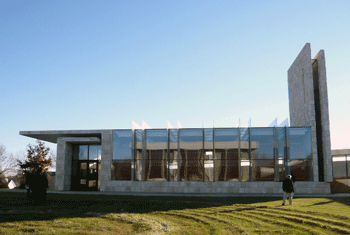We asked two experts, one an architect and the other a sacred space planner, a series of questions about church design today. In the May 23 issue, Roberto Chiotti and Richard S. Vosko suggest three things that American Catholics should know about church design. We also asked them to cite a recent project they admire, and to name an up and coming church designer.
The Editors
While deliberating the submissions for the 2010 Faith & Form/IFRAA International Awards Program for Religious Art & Architecture, I was drawn to the St. Bartholomew’s Chapel in Valley Center, California by Kevin deFreitas Architects for the significant amount of site-harvested materials used in its reconstruction. The beautifully organic hues and texture of the sanctuary’s rammed-earth sidewalls, sculpted from 120 tons of sacred reservation soil, tangibly and symbolically ground the new sacred space within its sacred earth context, while manifesting the client’s desires to pursue LEED Gold certification. The roof appears to float above these walls, which are situated to afford visual connections to the congregation’s surrounding ancestral home.
I think we should be encouraging up and coming church architects/designers to embody and reflect in their work an understanding of early scriptural teachings that emphasized the sacredness of all creation and not just the sacredness of humankind. As Catholics who are willing to re-claim these important insights along with embracing creation as a primary revelatory experience we can offer the world a significant contribution towards achieving an earth justice that will enable the realization of gospel values that promote peace and social justice for all. Our sacred spaces can and should become opportunities for catechesis, engaging our senses, awakening our spirits and inviting transformation.
-- Roberto Chiotti
There are several talented architects doing good work. One of them is Joan Soranno, FAIA (HGA Architects, Minneapolis, Minn.) who designed the Bigelow Chapel at United Theological Seminary, New Brighton, Minn. The shape of the place is evocative, refreshing and functional. The materials are organic and integral to the plan. Abundant natural light in this flexible environment creates an atmosphere that fosters a feeling of the sacred. One could say this chapel is a venue for experiencing the ineffable holy one in both an immanent and transcendent way (See photos).
There are few design professionals who are bringing a fresh interpretation to the field of religious art and architecture. One of them is Victor Trahan, FAIA. His use of architectural concrete to create more ascetic places is inspiring and reminiscent of some of the more contemporary church buildings in the European Union. His designs invite the congregation to engage with the ritual actions that occur around various focal points without being distracted by excessive ornament or stylistic fashion. The use of light, harmony, verticality and materials invites contemplation even during public worship.
-- Richard S. Vosko
View a slideshow of newly designed churches.







